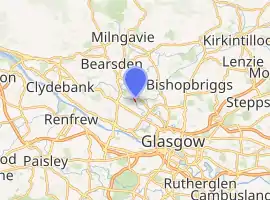Kelvin Aqueduct
The Kelvin Aqueduct is a navigable aqueduct in Glasgow, Scotland, which carries the Forth and Clyde Canal over the River Kelvin.
Kelvin Aqueduct | |
|---|---|
.jpg.webp) The Forth and Clyde Canal passing over the Kelvin Aqueduct | |
| Coordinates | 55°53′33″N 4°18′06″W |
| Carries | Forth and Clyde Canal |
| Crosses | River Kelvin |
| Characteristics | |
| Material | Stone |
| Longest span | 50 ft (15 m) |
| No. of spans | 4 |
| History | |
| Construction end | 1787 |
| Construction cost | £8,509 |
| Opened | 1790 |
| Location | |

| |
History

It was designed by Robert Whitworth, one of John Smeaton's supervising engineers on the Forth and Clyde Canal project.[1] The contractors were William Gibb (founder of the engineering dynasty that led to Sir Alexander Gibb & Partners) and John Muir, who also built the nearby Maryhill locks.[1] A foundation stone was laid on 16 June 1787 by Archibald Spiers, the chairman of the canal committee.[2]
When opened in 1790 it was Britain's largest aqueduct,[3] and onlookers were impressed at the sight of sailing boats crossing above them.[4] The entire project cost £8,509, exceeding the original estimated cost of £6,200.[2]
It was protected as a category A listed building in 1989.[5]
Design
It is 445 feet (136 metres) long, with four arches of 50-foot (15 m) span, and 62 feet (19 m) high above the surface of the river.[3] According to measurements by John Rennie as the canal was nearing completion, there was around 3 feet (0.9 m) of puddle clay at the bottom of the canal.[3] The aqueduct was designed to carry a depth of 8 feet (2.4 m) of water.[6]
The piers are buttressed in such a way as to resemble cutwaters, but only one pier sits in the river.[2] The sides of the aqueduct are arched in order to transfer the outward pressure of the water onto the buttresses, an effect which can clearly be seen from above.[7][8] This design feature is also present on the Luggie Aqueduct at Kirkintilloch, which opened in 1773.[9]
The aqueduct is built from rustic masonry at the lower levels and polished ashlar above.[3] Underneath it is the Kelvin Walkway, which runs through an area of green space around the river.[2][8]
References
- "Kelvin Aqueduct". engineering-timelines.com. Archived from the original on 4 March 2016. Retrieved 17 September 2014.
- "Glasgow, Maryhill, Forth and Clyde Canal, Kelvin Aqueduct". rcahms.gov.uk. Retrieved 17 September 2014.
- Arch Bridges and Their Builders 1735-1835. CUP Archive. pp. 128–129. GGKEY:FQ9ZF6QS0H8.
- Dowds, Thomas J. (2003). The Forth and Clyde Canal: A History. Dundurn. p. 48. ISBN 978-1-86232-232-5.
- Historic Environment Scotland. "Forth and Clyde Canal Aqueduct (adjoining Skaethorn Road Bridge) (Category A Listed Building) (LB32316)". Retrieved 28 March 2019.
- Skempton, A. W. (2002). A Biographical Dictionary of Civil Engineers in Great Britain and Ireland: 1500-1830. Thomas Telford. p. 250. ISBN 978-0-7277-2939-2.
- Paterson, Len (2013). From Sea to Sea: A History of the Scottish Lowland and Highland Canals. Neil Wilson Publishing. p. 49. ISBN 978-1-906000-34-9.
- Google (17 September 2014). "Kelvin Aqueduct" (Map). Google Maps. Google. Retrieved 17 September 2014.
- "Luggie Aqueduct". engineering-timelines.com. Retrieved 17 September 2014.
External links
| Wikimedia Commons has media related to Kelvin Aqueduct. |